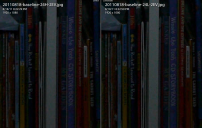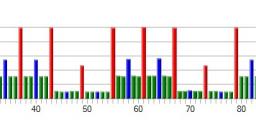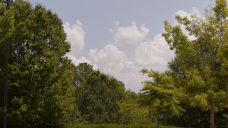
AVCHD maximum image quality settings and testing
-
@stonebat - with that in mind would you recommend staying at gop 3 for now? Does AQ4 make a difference? It seemed to really up the bitrate overall for our last tests at 88Mbps.
-
I think it's a bug. Increasing overall bitrate didn't help. Lowering AQ helped. The issue goes away at AQ0. I've seen the patterns before. It happened in 66Mbps GOP6 and 88Mbps GOP6, too. 88Mbps GOP3 AQ3 didn't have any issue, but it failed high detail test.
44Mbps GOP12 AQ3 is looking good. I frame size reaching 7Mbps. B & P frames looking "healthy". Good candidate for baseline 24L setting. -
@stonebat
It sure looks like a bug to me. Something with buffering. Maybe we should switch over to GOP 12 for now, at least for this thread. I've tested the hell out of 44M and haven't had a single problem. I'm using transcend class 10 cards. Now I'm going to switch over to 66M, AQ=4, and buffers doubled (not tripled). In fact I might try unchanged buffers, doubled buffers, and tripled buffers and see how much of a difference there is.
Chris -
I used 44Mbps GOP6 AQ3 setting above.
1st pic comparison at 0 EV. 2nd pic at -2 EV. I used Lightroom to zoom in. I couldn't find any difference between 24H and 24L.
The stream parser showed almost identical charts. BTW it's the same pattern again. Lower GOP cycles followed by higher GOP cycles... all the way to the end. Is this a bug?
 Screen shot 2011-08-18 at 8.26.05 PM.png1381 x 868 - 419K
Screen shot 2011-08-18 at 8.26.05 PM.png1381 x 868 - 419K
 Screen shot 2011-08-18 at 8.27.05 PM.png1370 x 866 - 356K
Screen shot 2011-08-18 at 8.27.05 PM.png1370 x 866 - 356K
 streamparsing.jpg1194 x 200 - 73K
streamparsing.jpg1194 x 200 - 73K -
So many hardware variables (lenses in particular), Ptool settings and test subjects/procedures makes for a lot of difficulty in comparing findings. Perhaps specifying a narrower range of hardware (e.g. focal length range) and test subject type/ camera-to-subject distance/ tripod or no tripod could help to reduce some of the extraneous variability of outcomes from different testers...and help home in on the in-camera parameter influences.
I've noticed in many of my tests (current and previous with the GH1) that what works for standard focal length lenses often comes to grief with wide-angles. Perhaps we should outline a basic test methodology...i.e. a consistent set of broad parameters (lens type; subject type; lighting characteristics; test subject characteristics; etc) that would more easily allow a comparison of test results.
This is all very exciting, innovative stuff. The real-world, end use implications are potentially amazing. -
@cbrandin Is it possible to capture a frame as jpeg from StreamParser? If it is not easy task, never mind.
-
Or install Vmware. Easy.
-
@cbrandin Great. How about doubling the default values, GOP6, AG3? I wanna test it on 24L and 24H... but it's raining now.

 seta.ini.zip771B
seta.ini.zip771B -
-delete-
-
I'll be happy to do it But I'm on a Mac and don't have StreamParser. That why I'm going with eyes only.
I'm getting a used PC in a couple of days and will do it if someone hasn't already. I'll try right now with 3x and see what happens. If you want I could send you a clips if that's possible meaning me how do I do that?
side note:
After reading your stuff I was thinking the buffers might increase the B & P frames.
I did have GOP 3 with out buffers yesterday at 66Mbps which looked good but todays settings look better blown up. -
@stonebat
That's a really good idea. I would run a simple test first, though. Put the same settings in 24H and 24L to make sure they come out the same. In the past there were some problems with 24L that I think Vitaliy fixed. It would be good to confirm that.
Chris -
@LukeV
I know this is a big request, but can you do the exact same test - once with frame buffers unchecked, once at 2x and once at 3x? It would be nice to see how the StreamParser graph changes between them (if at all).
Chris -
@cbrandin
Well done Chris. This is exactly the type of info that is useful in real world situations. Great stuff! -
@cbrandin
I'm testing only by eye but I asked about buffer size yesterday and low GOP I hope it's OK to post. I'm with you on maximum quality.What I mean also by quality is the ability to color correct to higher spectrum. I think it really good already thanks to VK and crew but we're here to help push ;)
I just 2x the Buffer size settings. I'm finding with the panny 14-42 I'm getting a rainbow on the camera monitor but when I tran code to proresHQ and play at 100% .
IT looks great. At 200% you can see some noise. I did test with a manual Nikon 35mm with way less rainbow and none when slightly under exposed. (I have the highlight off in menu.) It's very stable only sometimes playback gives message just shut camera down and up to see play back. If you or anyone want to try it for yourself I'd love to hear what you see.
my settings 24H-GOP6- 66Mbps AQ3
720p SH-GOP6-42Mbps AQ-0
Frame buffer size 2x
bitrate settings 2x
 setf.zip621B
setf.zip621B -
If enough people participate, we'll find a good enough base setting in a few days. 44Mbps sounds good. Initially it doesn't need to be perfect. Save it as 24L mode. Then we use the baseline to compare with all new settings in 24H. How does it sound?
-
Here are a few things I know for sure:
The factory firmware image quality can be improved upon - this I tested under controlled circumstances.
Raising the bitrate makes it possible to make other improvements.
AQ doesn't do anything unless you have raised the bitrate.
AQ settings improve image quality - the higher the number, the more improvement.
There is a hard limit of 8 megabits (1 MB) per frame.
Raising the buffer (FBx) and frame limit removes the 8 megabit limit.
P and B frames do not improve upon I frames. This is by design to avoid detail pulsing.
Therefore the first step to improving image quality is to maximize I frame quality.
Here are a few things I strongly suspect:
Now, if all you do is raise bitrate you are still stuck with 8 megabit I frames at best. Even the factory firmware can do about 6-7 megabits per I frame. So, where is the rest of the bandwidth going? Mostly to better encoding of motion. It's probably overdoing it and producing little, if any additional quality at very high bitrates.
My current thinking is to set AQ to 4 - I think there is still plenty of bandwidth available for the motion encoding.
Extreme bitrates have probably reached the point of diminishing returns by the time you reach 65-70M, maybe even before. This may not be true with short GOP. However the GOP 3 patches seem to produce a maximum I frame size well below 6 megabits - which isn't really very high. I've been able to get I frames of over 9 megabits with regular GOP settings - it doesn't sound like a big improvement, but it actually makes a significant difference in image quality - especially in lower parts of the frame.
Here's what I want to figure out:
I have suggested increasing FBx and frame limit in proportion to the bitrate increase. I'm not sure this is appropriate. For example, if you go to 66M and double the buffer numbers instead of tripling them does it make any difference?
Chris
-
Great thread.
I think my preferred settings would be maximum image quality while being totally stable on at least one type of card speed (even if very high). I think that was somewhat implicit in what you were after Chris?
With the original gh1 hack, there were several star charts that people were using that was a good, fast, and reliable test of whether a patch would freeze or not. I think would be good if people also made use of this method as just one important test for *stability*. Maybe people already are. Where to get a good star chart? -
Good idea!
-
@stonebat
You can always set the Low settings to ones that are more reliable and the high settings to ones that give you good reliability with ultimate quality. Just switch back and forth as the need arises. -
@vvfmoron
I found 142 mbps to be not reliable at all. Can you post some examples of how it is reliable? I get constant write failures for anything over about 70 mb/sec even with a class 10 card. Are you changing anything else? -
Just like that... you found a needle in a haystack. How do you know that 144Mbps gives better image quality than 44Mbps? How would you improve it without knowing how those parameters work? When we get next PTools, you'd need to find a needle in a haystack again...
Read @cbrandin's 1st post. Start over again. -
Low-contrast static images are what I am most interested in improving. I have been using AQ4 only. I have found that 142mbps is reliable enough. I assumed 142mbps is better than 44mbps but I haven't been able to produce a test that shows any difference. I have played with frame buffer settings as well but haven't made any advances and I don't understand how they work in combination with everything else.
What specifically can I do to test the the limits of image quality? -
I'm not sure about finding maximum quality or maximum bitrate settings or stable settings. There are so many variables. My failed test with 20mm pancake might have been passed with FD 50mm. Maybe filters. Maybe film mode settings. Maybe different camera batch production. Maybe different scenes. Maybe how fast subject moves. Maybe how fast panning goes. Maybe different ISO.
Having a guideline on how to test stuffs seems quite enough for now, and Chris explained it well here. Exact parameter settings may not be important. Having basic idea about how each parameter change would impact the overall image quality and system stability would be valuable.
88Mbps GOP3 AQ3 didn't give me any error until I tested out my bush of death test. But what's the chance that I would run into such bush of death in real shooting? Zero... for me. So I might just keep the setting. Important thing is that I know drawback and trade-off. Then it becomes my working setting which might sound really selfish... but that's the way it is. There are too many variations.
Each of us should learn how to play with the parameters. Then share the knowledge about patterns. I learned that higher GOP doesn't make it more stable. Lower bitrate doesn't make it more stable because other settings might demand higher bandwidth. Chris is saying that higher bitrate doesn't imply better image quality. We need more information like that which helps find one's working setting. Seriously... finding one's working setting shouldn't be like looking for a needle in a haystack. -
That looks very nice... I look forward to seeing your settings.
Chris -
@cbrandin
I am 100% with you man. I believe that we have been too focused on what bit rate can we achieve as opposed to how good can we make the video look.
I think this still frame taken from a 1080p video looks really good. There is no banding in the sky and each one of the leaves are rendered accurately. If you can achieve better image quality for an image like this then I would love to know how.
 Rez Tests00001.png1920 x 1080 - 4M
Rez Tests00001.png1920 x 1080 - 4M
This topic is closed.
← All Discussions Start New Topic


Howdy, Stranger!
It looks like you're new here. If you want to get involved, click one of these buttons!
Categories
- Topics List23,993
- Blog5,725
- General and News1,354
- Hacks and Patches1,153
- ↳ Top Settings33
- ↳ Beginners256
- ↳ Archives402
- ↳ Hacks News and Development56
- Cameras2,368
- ↳ Panasonic995
- ↳ Canon118
- ↳ Sony156
- ↳ Nikon96
- ↳ Pentax and Samsung70
- ↳ Olympus and Fujifilm102
- ↳ Compacts and Camcorders300
- ↳ Smartphones for video97
- ↳ Pro Video Cameras191
- ↳ BlackMagic and other raw cameras116
- Skill1,960
- ↳ Business and distribution66
- ↳ Preparation, scripts and legal38
- ↳ Art149
- ↳ Import, Convert, Exporting291
- ↳ Editors191
- ↳ Effects and stunts115
- ↳ Color grading197
- ↳ Sound and Music280
- ↳ Lighting96
- ↳ Software and storage tips266
- Gear5,420
- ↳ Filters, Adapters, Matte boxes344
- ↳ Lenses1,582
- ↳ Follow focus and gears93
- ↳ Sound499
- ↳ Lighting gear314
- ↳ Camera movement230
- ↳ Gimbals and copters302
- ↳ Rigs and related stuff273
- ↳ Power solutions83
- ↳ Monitors and viewfinders340
- ↳ Tripods and fluid heads139
- ↳ Storage286
- ↳ Computers and studio gear560
- ↳ VR and 3D248
- Showcase1,859
- Marketplace2,834
- Offtopic1,320





